Global Financial Crisis: A Geographical Analysis of Core vs. Periphery
VerifiedAdded on 2020/02/05
|35
|10644
|407
Report
AI Summary
This report provides a comprehensive geographical analysis of the 2007-2008 global financial crisis, often referred to as the Great Recession, focusing on the differential impacts on core and periphery countries. It begins with an introduction to the crisis, its origins in the US subprime mortgage market, and its subsequent spread globally. The report then examines the literature, defining the global financial crisis and its impact on both core and periphery nations, including their respective recovery paths. The research methodology outlines the research philosophy, approach, and methods used, including data collection and analysis techniques. The findings section presents quantitative analysis, comparing economic stability before and after the crisis for both sets of countries. Finally, the report concludes with recommendations and assesses the dependency theory's relevance in explaining the crisis's impact, offering insights into economic vulnerabilities and potential policy implications for managing future financial downturns. The report emphasizes the role of dependency between core and periphery economies in the severity of the crisis's impact.
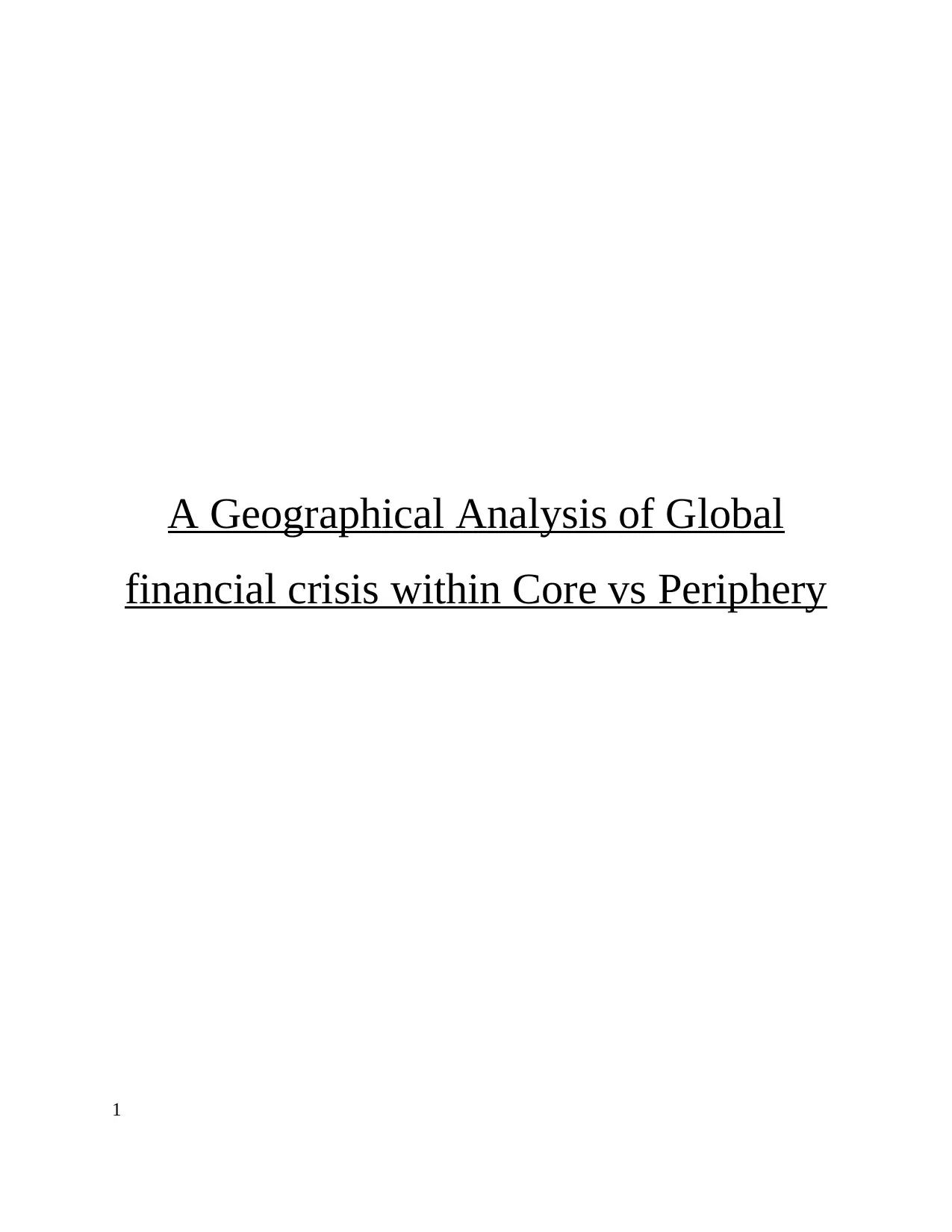
A Geographical Analysis of Global
financial crisis within Core vs Periphery
1
financial crisis within Core vs Periphery
1
Paraphrase This Document
Need a fresh take? Get an instant paraphrase of this document with our AI Paraphraser

TABLE OF CONTENTS
CHAPTER -1 INTRODUCTION ...................................................................................................4
1.1 Background............................................................................................................................4
1.2 Problem statement..................................................................................................................5
1.3 Research aim..........................................................................................................................5
1.4 Research objectives................................................................................................................5
1.5 Research questions.................................................................................................................6
1.6 Significance of research.........................................................................................................6
1.7 Dissertation structure.............................................................................................................6
CHAPTER- 2 LITERATURE REVIEW ........................................................................................8
2.1 Introduction............................................................................................................................8
2.2 Concept of global financial crisis..........................................................................................8
2.3 Impact of global financial crisis on core countries & periphery countries............................9
2.4 Recovery from global financial crisis for core countries & peripheral countries................10
2.5 Comparison of economic stability post and pre-crisis for the core and peripheral countries
....................................................................................................................................................11
2.6 Dependency between two sets of economies.......................................................................12
CHAPTER- 3 RESEARCH METHODOLOGY ..........................................................................13
3.1 Introduction..........................................................................................................................13
3.2 Research philosophy............................................................................................................13
3.3 Research approach ..............................................................................................................13
3.4 Research methods ...............................................................................................................14
3.5 Data collection.....................................................................................................................14
3.6 Data analysis .......................................................................................................................15
3.7 Reliability and validity.........................................................................................................15
3.8 Ethical consideration............................................................................................................16
3.6 Research limitation..............................................................................................................16
CHAPTER- 4 DATA ANALYSIS AND FINDINGS ..................................................................18
4.1 Introduction..........................................................................................................................18
4.2 Quantitative analysis............................................................................................................18
CHAPTER- 5 RECOMMENDATION AND CONCLUSION ....................................................33
5.1 Conclusion...........................................................................................................................33
5.2 Recommendation.................................................................................................................33
2
CHAPTER -1 INTRODUCTION ...................................................................................................4
1.1 Background............................................................................................................................4
1.2 Problem statement..................................................................................................................5
1.3 Research aim..........................................................................................................................5
1.4 Research objectives................................................................................................................5
1.5 Research questions.................................................................................................................6
1.6 Significance of research.........................................................................................................6
1.7 Dissertation structure.............................................................................................................6
CHAPTER- 2 LITERATURE REVIEW ........................................................................................8
2.1 Introduction............................................................................................................................8
2.2 Concept of global financial crisis..........................................................................................8
2.3 Impact of global financial crisis on core countries & periphery countries............................9
2.4 Recovery from global financial crisis for core countries & peripheral countries................10
2.5 Comparison of economic stability post and pre-crisis for the core and peripheral countries
....................................................................................................................................................11
2.6 Dependency between two sets of economies.......................................................................12
CHAPTER- 3 RESEARCH METHODOLOGY ..........................................................................13
3.1 Introduction..........................................................................................................................13
3.2 Research philosophy............................................................................................................13
3.3 Research approach ..............................................................................................................13
3.4 Research methods ...............................................................................................................14
3.5 Data collection.....................................................................................................................14
3.6 Data analysis .......................................................................................................................15
3.7 Reliability and validity.........................................................................................................15
3.8 Ethical consideration............................................................................................................16
3.6 Research limitation..............................................................................................................16
CHAPTER- 4 DATA ANALYSIS AND FINDINGS ..................................................................18
4.1 Introduction..........................................................................................................................18
4.2 Quantitative analysis............................................................................................................18
CHAPTER- 5 RECOMMENDATION AND CONCLUSION ....................................................33
5.1 Conclusion...........................................................................................................................33
5.2 Recommendation.................................................................................................................33
2

REFERENCES..............................................................................................................................34
3
3
⊘ This is a preview!⊘
Do you want full access?
Subscribe today to unlock all pages.

Trusted by 1+ million students worldwide
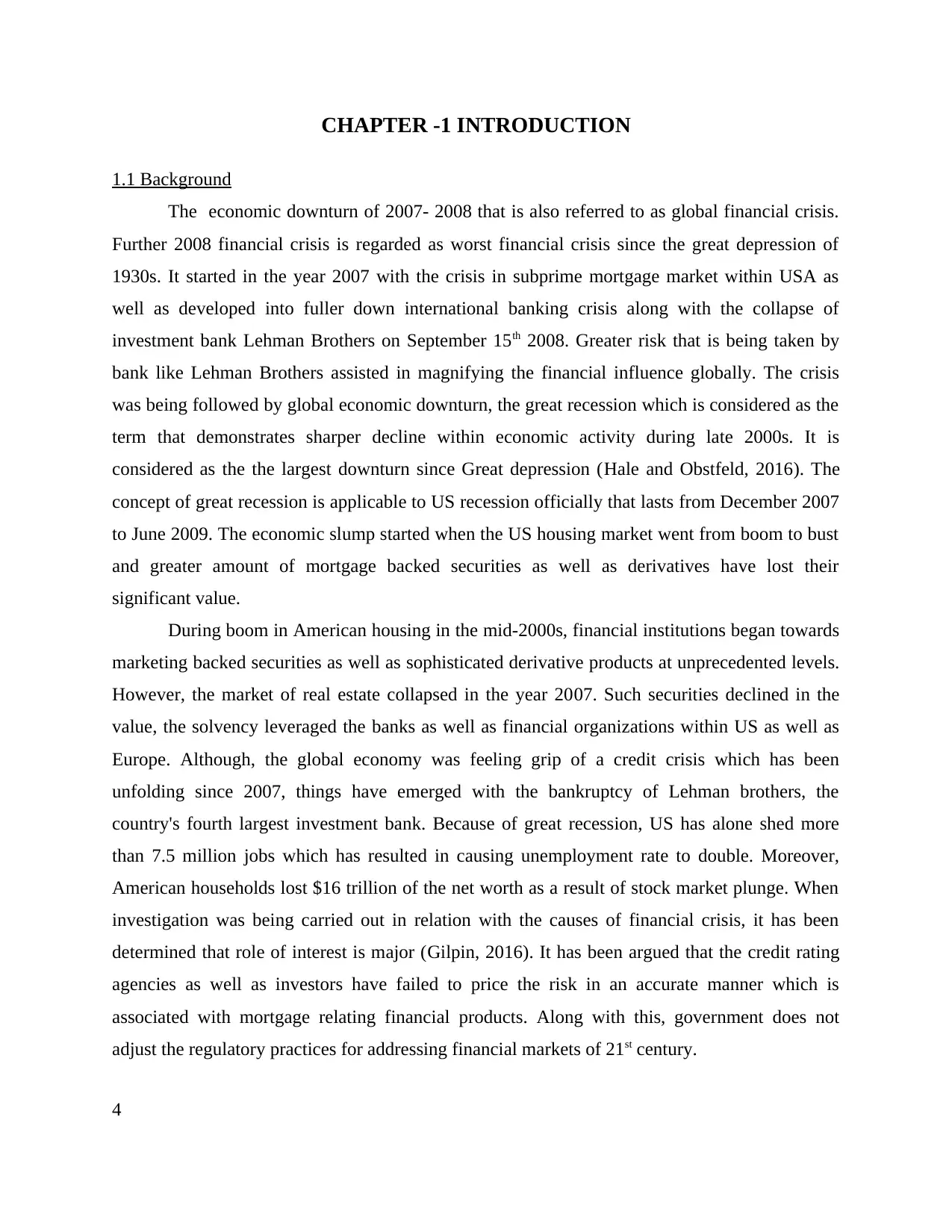
CHAPTER -1 INTRODUCTION
1.1 Background
The economic downturn of 2007- 2008 that is also referred to as global financial crisis.
Further 2008 financial crisis is regarded as worst financial crisis since the great depression of
1930s. It started in the year 2007 with the crisis in subprime mortgage market within USA as
well as developed into fuller down international banking crisis along with the collapse of
investment bank Lehman Brothers on September 15th 2008. Greater risk that is being taken by
bank like Lehman Brothers assisted in magnifying the financial influence globally. The crisis
was being followed by global economic downturn, the great recession which is considered as the
term that demonstrates sharper decline within economic activity during late 2000s. It is
considered as the the largest downturn since Great depression (Hale and Obstfeld, 2016). The
concept of great recession is applicable to US recession officially that lasts from December 2007
to June 2009. The economic slump started when the US housing market went from boom to bust
and greater amount of mortgage backed securities as well as derivatives have lost their
significant value.
During boom in American housing in the mid-2000s, financial institutions began towards
marketing backed securities as well as sophisticated derivative products at unprecedented levels.
However, the market of real estate collapsed in the year 2007. Such securities declined in the
value, the solvency leveraged the banks as well as financial organizations within US as well as
Europe. Although, the global economy was feeling grip of a credit crisis which has been
unfolding since 2007, things have emerged with the bankruptcy of Lehman brothers, the
country's fourth largest investment bank. Because of great recession, US has alone shed more
than 7.5 million jobs which has resulted in causing unemployment rate to double. Moreover,
American households lost $16 trillion of the net worth as a result of stock market plunge. When
investigation was being carried out in relation with the causes of financial crisis, it has been
determined that role of interest is major (Gilpin, 2016). It has been argued that the credit rating
agencies as well as investors have failed to price the risk in an accurate manner which is
associated with mortgage relating financial products. Along with this, government does not
adjust the regulatory practices for addressing financial markets of 21st century.
4
1.1 Background
The economic downturn of 2007- 2008 that is also referred to as global financial crisis.
Further 2008 financial crisis is regarded as worst financial crisis since the great depression of
1930s. It started in the year 2007 with the crisis in subprime mortgage market within USA as
well as developed into fuller down international banking crisis along with the collapse of
investment bank Lehman Brothers on September 15th 2008. Greater risk that is being taken by
bank like Lehman Brothers assisted in magnifying the financial influence globally. The crisis
was being followed by global economic downturn, the great recession which is considered as the
term that demonstrates sharper decline within economic activity during late 2000s. It is
considered as the the largest downturn since Great depression (Hale and Obstfeld, 2016). The
concept of great recession is applicable to US recession officially that lasts from December 2007
to June 2009. The economic slump started when the US housing market went from boom to bust
and greater amount of mortgage backed securities as well as derivatives have lost their
significant value.
During boom in American housing in the mid-2000s, financial institutions began towards
marketing backed securities as well as sophisticated derivative products at unprecedented levels.
However, the market of real estate collapsed in the year 2007. Such securities declined in the
value, the solvency leveraged the banks as well as financial organizations within US as well as
Europe. Although, the global economy was feeling grip of a credit crisis which has been
unfolding since 2007, things have emerged with the bankruptcy of Lehman brothers, the
country's fourth largest investment bank. Because of great recession, US has alone shed more
than 7.5 million jobs which has resulted in causing unemployment rate to double. Moreover,
American households lost $16 trillion of the net worth as a result of stock market plunge. When
investigation was being carried out in relation with the causes of financial crisis, it has been
determined that role of interest is major (Gilpin, 2016). It has been argued that the credit rating
agencies as well as investors have failed to price the risk in an accurate manner which is
associated with mortgage relating financial products. Along with this, government does not
adjust the regulatory practices for addressing financial markets of 21st century.
4
Paraphrase This Document
Need a fresh take? Get an instant paraphrase of this document with our AI Paraphraser
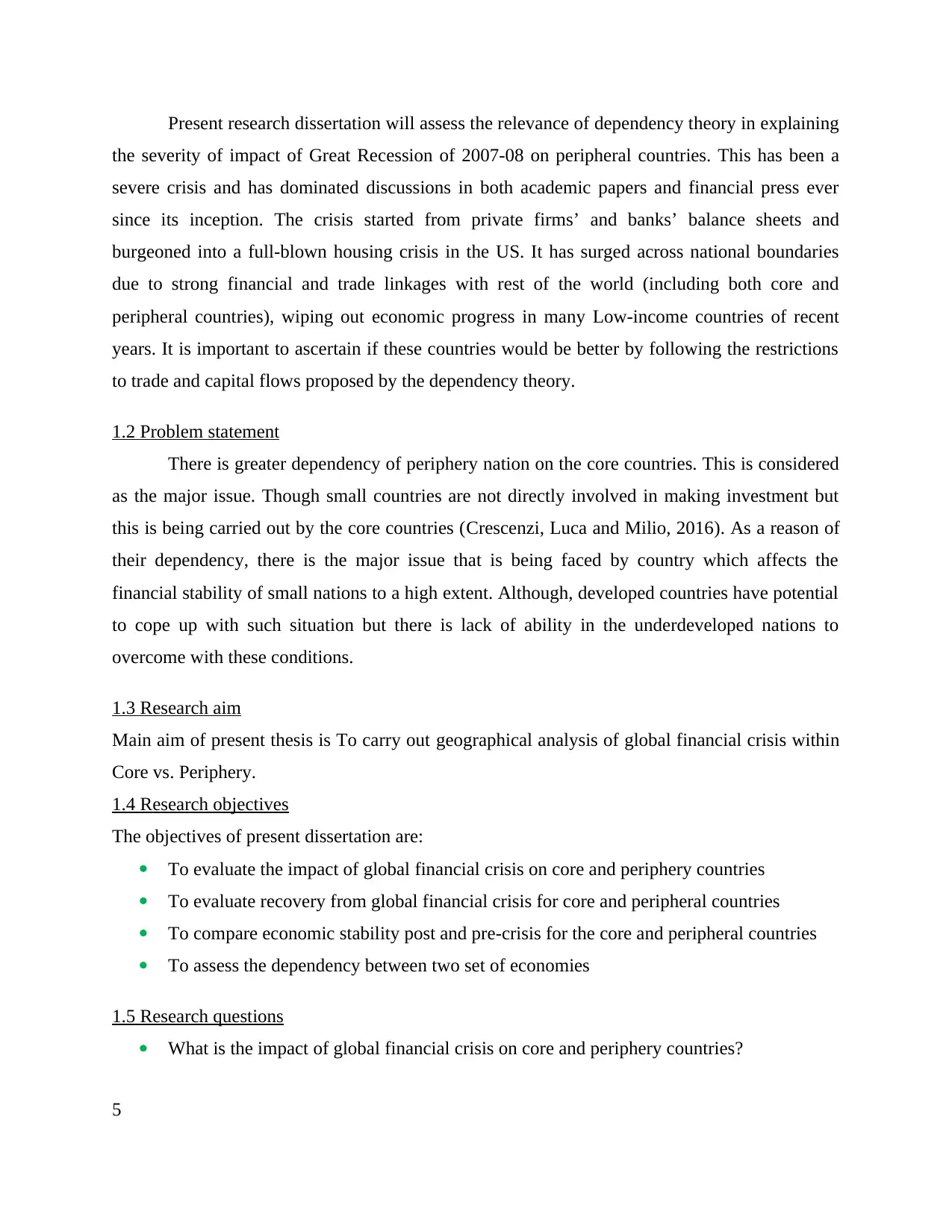
Present research dissertation will assess the relevance of dependency theory in explaining
the severity of impact of Great Recession of 2007-08 on peripheral countries. This has been a
severe crisis and has dominated discussions in both academic papers and financial press ever
since its inception. The crisis started from private firms’ and banks’ balance sheets and
burgeoned into a full-blown housing crisis in the US. It has surged across national boundaries
due to strong financial and trade linkages with rest of the world (including both core and
peripheral countries), wiping out economic progress in many Low-income countries of recent
years. It is important to ascertain if these countries would be better by following the restrictions
to trade and capital flows proposed by the dependency theory.
1.2 Problem statement
There is greater dependency of periphery nation on the core countries. This is considered
as the major issue. Though small countries are not directly involved in making investment but
this is being carried out by the core countries (Crescenzi, Luca and Milio, 2016). As a reason of
their dependency, there is the major issue that is being faced by country which affects the
financial stability of small nations to a high extent. Although, developed countries have potential
to cope up with such situation but there is lack of ability in the underdeveloped nations to
overcome with these conditions.
1.3 Research aim
Main aim of present thesis is To carry out geographical analysis of global financial crisis within
Core vs. Periphery.
1.4 Research objectives
The objectives of present dissertation are:
To evaluate the impact of global financial crisis on core and periphery countries
To evaluate recovery from global financial crisis for core and peripheral countries
To compare economic stability post and pre-crisis for the core and peripheral countries
To assess the dependency between two set of economies
1.5 Research questions
What is the impact of global financial crisis on core and periphery countries?
5
the severity of impact of Great Recession of 2007-08 on peripheral countries. This has been a
severe crisis and has dominated discussions in both academic papers and financial press ever
since its inception. The crisis started from private firms’ and banks’ balance sheets and
burgeoned into a full-blown housing crisis in the US. It has surged across national boundaries
due to strong financial and trade linkages with rest of the world (including both core and
peripheral countries), wiping out economic progress in many Low-income countries of recent
years. It is important to ascertain if these countries would be better by following the restrictions
to trade and capital flows proposed by the dependency theory.
1.2 Problem statement
There is greater dependency of periphery nation on the core countries. This is considered
as the major issue. Though small countries are not directly involved in making investment but
this is being carried out by the core countries (Crescenzi, Luca and Milio, 2016). As a reason of
their dependency, there is the major issue that is being faced by country which affects the
financial stability of small nations to a high extent. Although, developed countries have potential
to cope up with such situation but there is lack of ability in the underdeveloped nations to
overcome with these conditions.
1.3 Research aim
Main aim of present thesis is To carry out geographical analysis of global financial crisis within
Core vs. Periphery.
1.4 Research objectives
The objectives of present dissertation are:
To evaluate the impact of global financial crisis on core and periphery countries
To evaluate recovery from global financial crisis for core and peripheral countries
To compare economic stability post and pre-crisis for the core and peripheral countries
To assess the dependency between two set of economies
1.5 Research questions
What is the impact of global financial crisis on core and periphery countries?
5
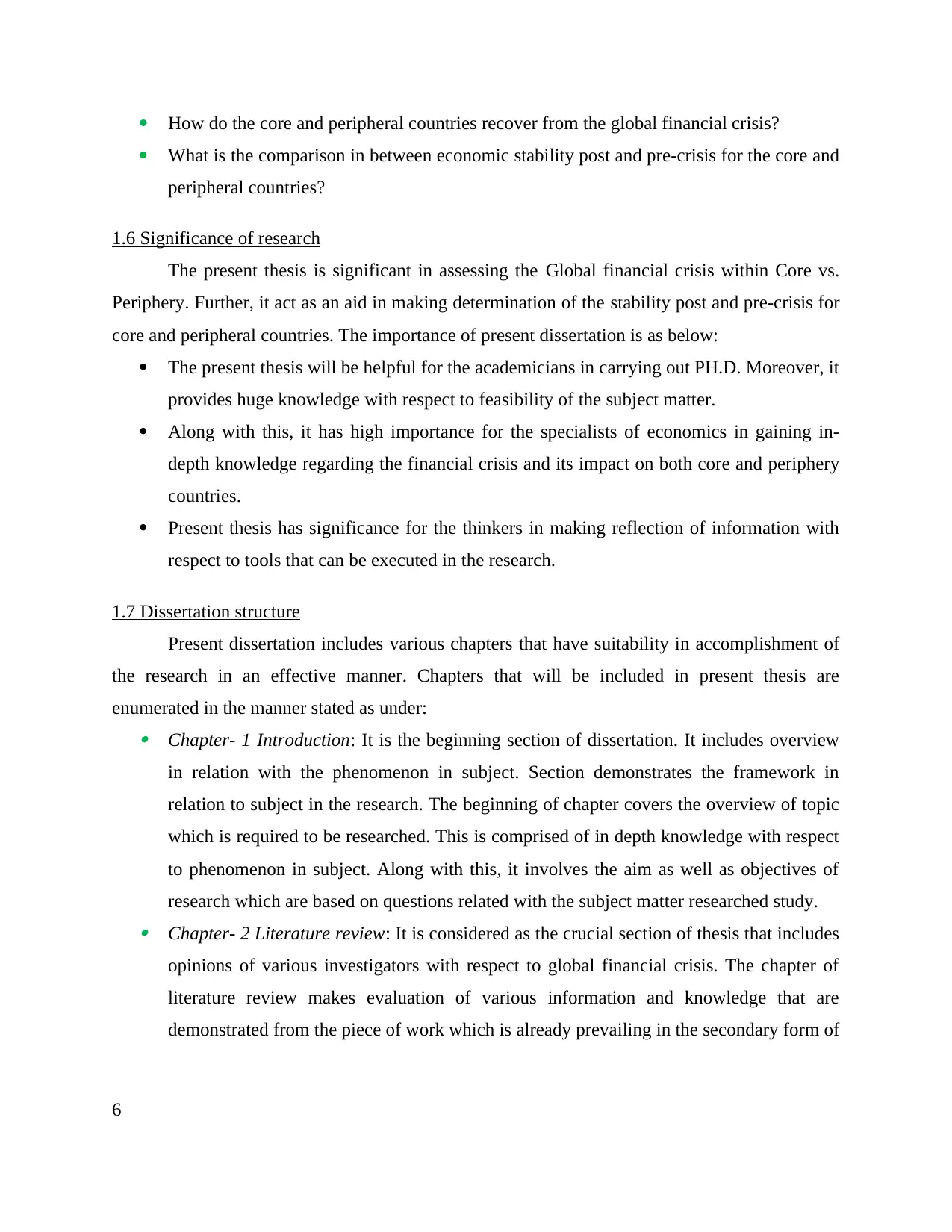
How do the core and peripheral countries recover from the global financial crisis?
What is the comparison in between economic stability post and pre-crisis for the core and
peripheral countries?
1.6 Significance of research
The present thesis is significant in assessing the Global financial crisis within Core vs.
Periphery. Further, it act as an aid in making determination of the stability post and pre-crisis for
core and peripheral countries. The importance of present dissertation is as below:
The present thesis will be helpful for the academicians in carrying out PH.D. Moreover, it
provides huge knowledge with respect to feasibility of the subject matter.
Along with this, it has high importance for the specialists of economics in gaining in-
depth knowledge regarding the financial crisis and its impact on both core and periphery
countries.
Present thesis has significance for the thinkers in making reflection of information with
respect to tools that can be executed in the research.
1.7 Dissertation structure
Present dissertation includes various chapters that have suitability in accomplishment of
the research in an effective manner. Chapters that will be included in present thesis are
enumerated in the manner stated as under: Chapter- 1 Introduction: It is the beginning section of dissertation. It includes overview
in relation with the phenomenon in subject. Section demonstrates the framework in
relation to subject in the research. The beginning of chapter covers the overview of topic
which is required to be researched. This is comprised of in depth knowledge with respect
to phenomenon in subject. Along with this, it involves the aim as well as objectives of
research which are based on questions related with the subject matter researched study. Chapter- 2 Literature review: It is considered as the crucial section of thesis that includes
opinions of various investigators with respect to global financial crisis. The chapter of
literature review makes evaluation of various information and knowledge that are
demonstrated from the piece of work which is already prevailing in the secondary form of
6
What is the comparison in between economic stability post and pre-crisis for the core and
peripheral countries?
1.6 Significance of research
The present thesis is significant in assessing the Global financial crisis within Core vs.
Periphery. Further, it act as an aid in making determination of the stability post and pre-crisis for
core and peripheral countries. The importance of present dissertation is as below:
The present thesis will be helpful for the academicians in carrying out PH.D. Moreover, it
provides huge knowledge with respect to feasibility of the subject matter.
Along with this, it has high importance for the specialists of economics in gaining in-
depth knowledge regarding the financial crisis and its impact on both core and periphery
countries.
Present thesis has significance for the thinkers in making reflection of information with
respect to tools that can be executed in the research.
1.7 Dissertation structure
Present dissertation includes various chapters that have suitability in accomplishment of
the research in an effective manner. Chapters that will be included in present thesis are
enumerated in the manner stated as under: Chapter- 1 Introduction: It is the beginning section of dissertation. It includes overview
in relation with the phenomenon in subject. Section demonstrates the framework in
relation to subject in the research. The beginning of chapter covers the overview of topic
which is required to be researched. This is comprised of in depth knowledge with respect
to phenomenon in subject. Along with this, it involves the aim as well as objectives of
research which are based on questions related with the subject matter researched study. Chapter- 2 Literature review: It is considered as the crucial section of thesis that includes
opinions of various investigators with respect to global financial crisis. The chapter of
literature review makes evaluation of various information and knowledge that are
demonstrated from the piece of work which is already prevailing in the secondary form of
6
⊘ This is a preview!⊘
Do you want full access?
Subscribe today to unlock all pages.

Trusted by 1+ million students worldwide
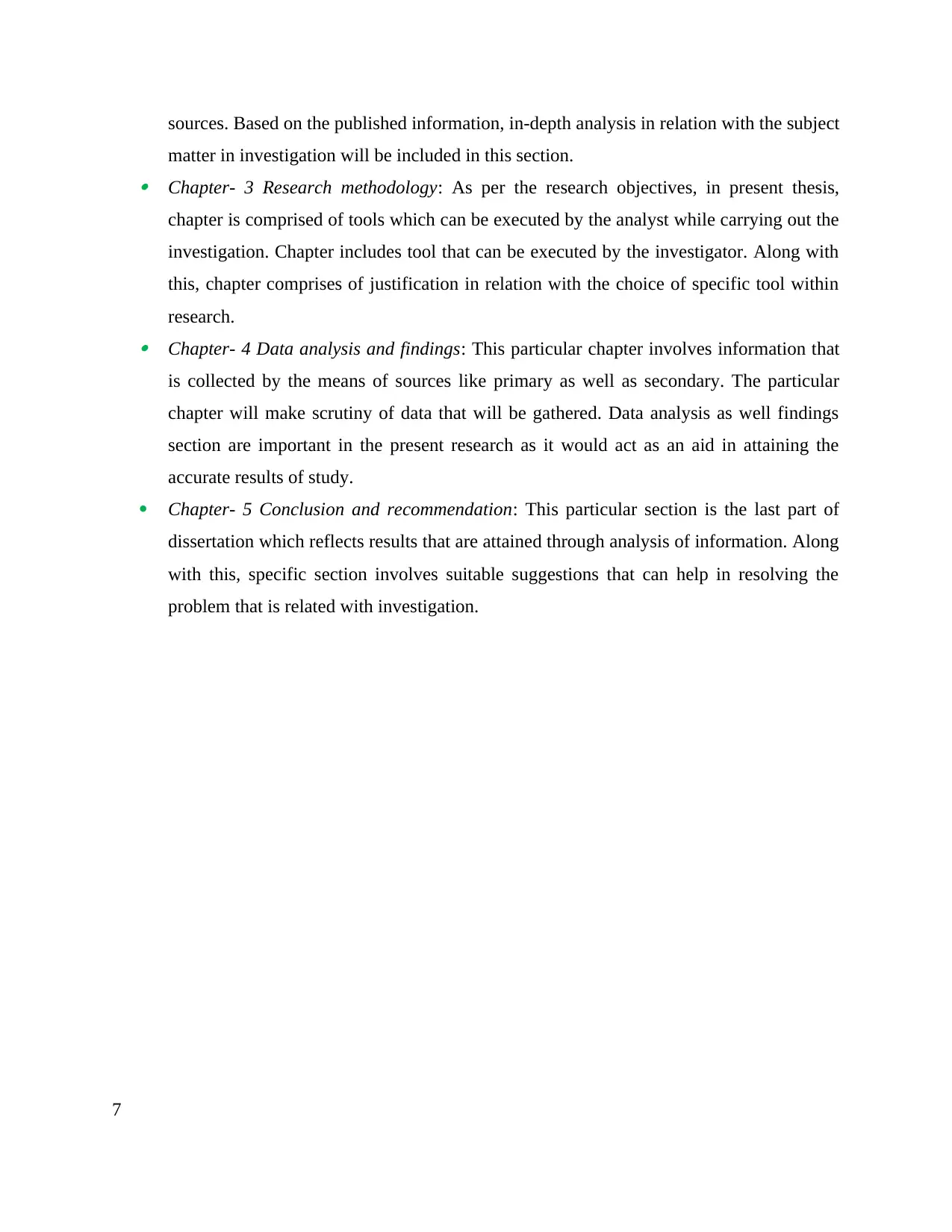
sources. Based on the published information, in-depth analysis in relation with the subject
matter in investigation will be included in this section. Chapter- 3 Research methodology: As per the research objectives, in present thesis,
chapter is comprised of tools which can be executed by the analyst while carrying out the
investigation. Chapter includes tool that can be executed by the investigator. Along with
this, chapter comprises of justification in relation with the choice of specific tool within
research. Chapter- 4 Data analysis and findings: This particular chapter involves information that
is collected by the means of sources like primary as well as secondary. The particular
chapter will make scrutiny of data that will be gathered. Data analysis as well findings
section are important in the present research as it would act as an aid in attaining the
accurate results of study.
Chapter- 5 Conclusion and recommendation: This particular section is the last part of
dissertation which reflects results that are attained through analysis of information. Along
with this, specific section involves suitable suggestions that can help in resolving the
problem that is related with investigation.
7
matter in investigation will be included in this section. Chapter- 3 Research methodology: As per the research objectives, in present thesis,
chapter is comprised of tools which can be executed by the analyst while carrying out the
investigation. Chapter includes tool that can be executed by the investigator. Along with
this, chapter comprises of justification in relation with the choice of specific tool within
research. Chapter- 4 Data analysis and findings: This particular chapter involves information that
is collected by the means of sources like primary as well as secondary. The particular
chapter will make scrutiny of data that will be gathered. Data analysis as well findings
section are important in the present research as it would act as an aid in attaining the
accurate results of study.
Chapter- 5 Conclusion and recommendation: This particular section is the last part of
dissertation which reflects results that are attained through analysis of information. Along
with this, specific section involves suitable suggestions that can help in resolving the
problem that is related with investigation.
7
Paraphrase This Document
Need a fresh take? Get an instant paraphrase of this document with our AI Paraphraser
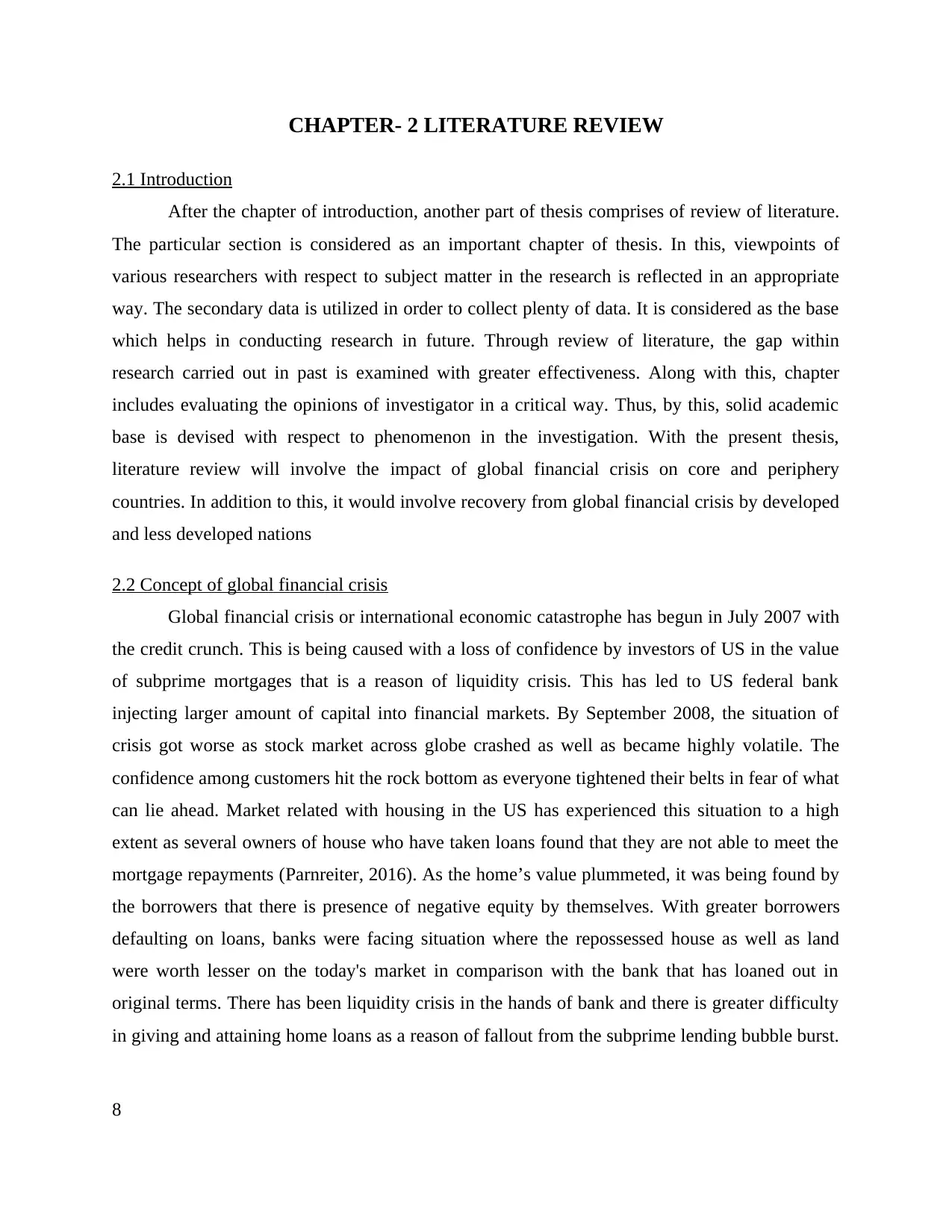
CHAPTER- 2 LITERATURE REVIEW
2.1 Introduction
After the chapter of introduction, another part of thesis comprises of review of literature.
The particular section is considered as an important chapter of thesis. In this, viewpoints of
various researchers with respect to subject matter in the research is reflected in an appropriate
way. The secondary data is utilized in order to collect plenty of data. It is considered as the base
which helps in conducting research in future. Through review of literature, the gap within
research carried out in past is examined with greater effectiveness. Along with this, chapter
includes evaluating the opinions of investigator in a critical way. Thus, by this, solid academic
base is devised with respect to phenomenon in the investigation. With the present thesis,
literature review will involve the impact of global financial crisis on core and periphery
countries. In addition to this, it would involve recovery from global financial crisis by developed
and less developed nations
2.2 Concept of global financial crisis
Global financial crisis or international economic catastrophe has begun in July 2007 with
the credit crunch. This is being caused with a loss of confidence by investors of US in the value
of subprime mortgages that is a reason of liquidity crisis. This has led to US federal bank
injecting larger amount of capital into financial markets. By September 2008, the situation of
crisis got worse as stock market across globe crashed as well as became highly volatile. The
confidence among customers hit the rock bottom as everyone tightened their belts in fear of what
can lie ahead. Market related with housing in the US has experienced this situation to a high
extent as several owners of house who have taken loans found that they are not able to meet the
mortgage repayments (Parnreiter, 2016). As the home’s value plummeted, it was being found by
the borrowers that there is presence of negative equity by themselves. With greater borrowers
defaulting on loans, banks were facing situation where the repossessed house as well as land
were worth lesser on the today's market in comparison with the bank that has loaned out in
original terms. There has been liquidity crisis in the hands of bank and there is greater difficulty
in giving and attaining home loans as a reason of fallout from the subprime lending bubble burst.
8
2.1 Introduction
After the chapter of introduction, another part of thesis comprises of review of literature.
The particular section is considered as an important chapter of thesis. In this, viewpoints of
various researchers with respect to subject matter in the research is reflected in an appropriate
way. The secondary data is utilized in order to collect plenty of data. It is considered as the base
which helps in conducting research in future. Through review of literature, the gap within
research carried out in past is examined with greater effectiveness. Along with this, chapter
includes evaluating the opinions of investigator in a critical way. Thus, by this, solid academic
base is devised with respect to phenomenon in the investigation. With the present thesis,
literature review will involve the impact of global financial crisis on core and periphery
countries. In addition to this, it would involve recovery from global financial crisis by developed
and less developed nations
2.2 Concept of global financial crisis
Global financial crisis or international economic catastrophe has begun in July 2007 with
the credit crunch. This is being caused with a loss of confidence by investors of US in the value
of subprime mortgages that is a reason of liquidity crisis. This has led to US federal bank
injecting larger amount of capital into financial markets. By September 2008, the situation of
crisis got worse as stock market across globe crashed as well as became highly volatile. The
confidence among customers hit the rock bottom as everyone tightened their belts in fear of what
can lie ahead. Market related with housing in the US has experienced this situation to a high
extent as several owners of house who have taken loans found that they are not able to meet the
mortgage repayments (Parnreiter, 2016). As the home’s value plummeted, it was being found by
the borrowers that there is presence of negative equity by themselves. With greater borrowers
defaulting on loans, banks were facing situation where the repossessed house as well as land
were worth lesser on the today's market in comparison with the bank that has loaned out in
original terms. There has been liquidity crisis in the hands of bank and there is greater difficulty
in giving and attaining home loans as a reason of fallout from the subprime lending bubble burst.
8
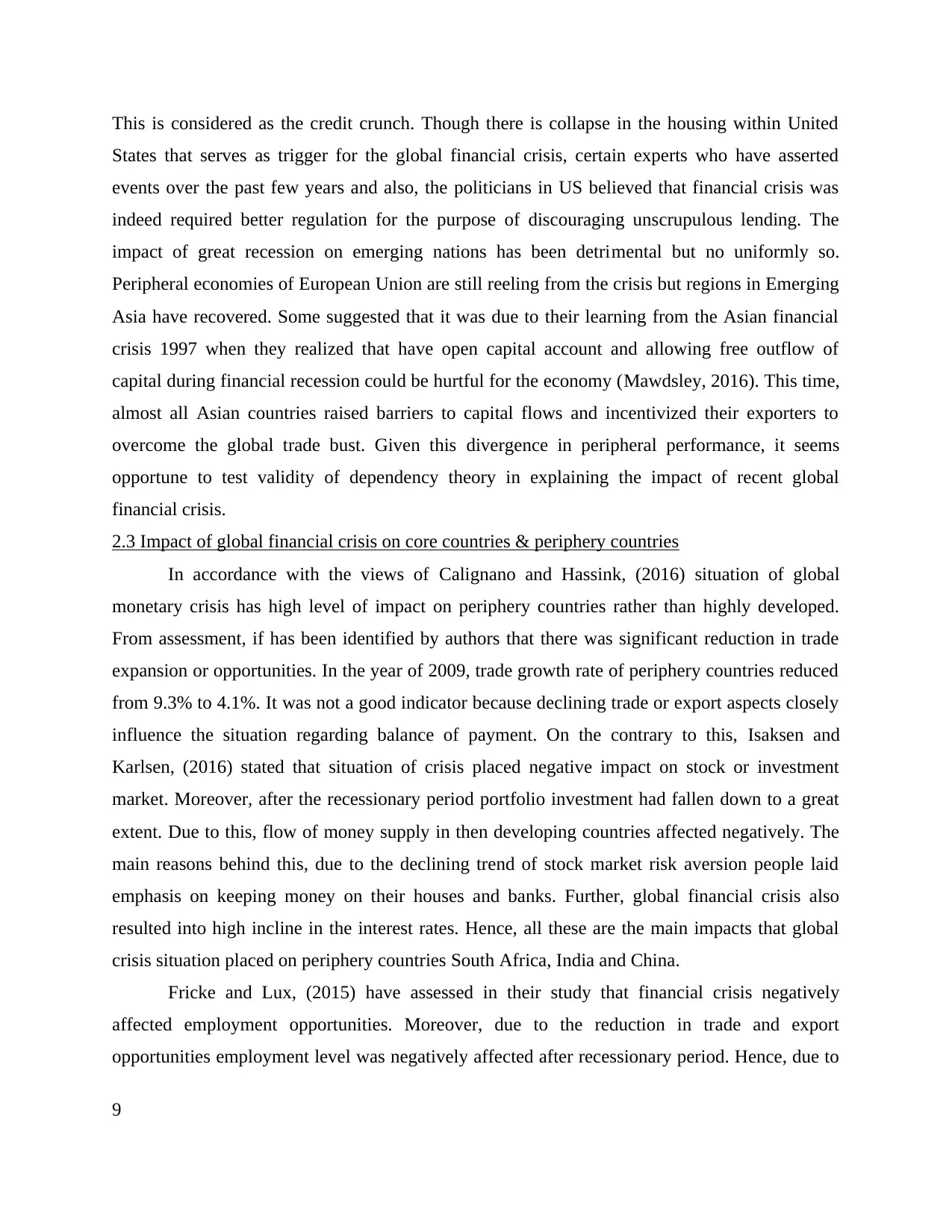
This is considered as the credit crunch. Though there is collapse in the housing within United
States that serves as trigger for the global financial crisis, certain experts who have asserted
events over the past few years and also, the politicians in US believed that financial crisis was
indeed required better regulation for the purpose of discouraging unscrupulous lending. The
impact of great recession on emerging nations has been detrimental but no uniformly so.
Peripheral economies of European Union are still reeling from the crisis but regions in Emerging
Asia have recovered. Some suggested that it was due to their learning from the Asian financial
crisis 1997 when they realized that have open capital account and allowing free outflow of
capital during financial recession could be hurtful for the economy (Mawdsley, 2016). This time,
almost all Asian countries raised barriers to capital flows and incentivized their exporters to
overcome the global trade bust. Given this divergence in peripheral performance, it seems
opportune to test validity of dependency theory in explaining the impact of recent global
financial crisis.
2.3 Impact of global financial crisis on core countries & periphery countries
In accordance with the views of Calignano and Hassink, (2016) situation of global
monetary crisis has high level of impact on periphery countries rather than highly developed.
From assessment, if has been identified by authors that there was significant reduction in trade
expansion or opportunities. In the year of 2009, trade growth rate of periphery countries reduced
from 9.3% to 4.1%. It was not a good indicator because declining trade or export aspects closely
influence the situation regarding balance of payment. On the contrary to this, Isaksen and
Karlsen, (2016) stated that situation of crisis placed negative impact on stock or investment
market. Moreover, after the recessionary period portfolio investment had fallen down to a great
extent. Due to this, flow of money supply in then developing countries affected negatively. The
main reasons behind this, due to the declining trend of stock market risk aversion people laid
emphasis on keeping money on their houses and banks. Further, global financial crisis also
resulted into high incline in the interest rates. Hence, all these are the main impacts that global
crisis situation placed on periphery countries South Africa, India and China.
Fricke and Lux, (2015) have assessed in their study that financial crisis negatively
affected employment opportunities. Moreover, due to the reduction in trade and export
opportunities employment level was negatively affected after recessionary period. Hence, due to
9
States that serves as trigger for the global financial crisis, certain experts who have asserted
events over the past few years and also, the politicians in US believed that financial crisis was
indeed required better regulation for the purpose of discouraging unscrupulous lending. The
impact of great recession on emerging nations has been detrimental but no uniformly so.
Peripheral economies of European Union are still reeling from the crisis but regions in Emerging
Asia have recovered. Some suggested that it was due to their learning from the Asian financial
crisis 1997 when they realized that have open capital account and allowing free outflow of
capital during financial recession could be hurtful for the economy (Mawdsley, 2016). This time,
almost all Asian countries raised barriers to capital flows and incentivized their exporters to
overcome the global trade bust. Given this divergence in peripheral performance, it seems
opportune to test validity of dependency theory in explaining the impact of recent global
financial crisis.
2.3 Impact of global financial crisis on core countries & periphery countries
In accordance with the views of Calignano and Hassink, (2016) situation of global
monetary crisis has high level of impact on periphery countries rather than highly developed.
From assessment, if has been identified by authors that there was significant reduction in trade
expansion or opportunities. In the year of 2009, trade growth rate of periphery countries reduced
from 9.3% to 4.1%. It was not a good indicator because declining trade or export aspects closely
influence the situation regarding balance of payment. On the contrary to this, Isaksen and
Karlsen, (2016) stated that situation of crisis placed negative impact on stock or investment
market. Moreover, after the recessionary period portfolio investment had fallen down to a great
extent. Due to this, flow of money supply in then developing countries affected negatively. The
main reasons behind this, due to the declining trend of stock market risk aversion people laid
emphasis on keeping money on their houses and banks. Further, global financial crisis also
resulted into high incline in the interest rates. Hence, all these are the main impacts that global
crisis situation placed on periphery countries South Africa, India and China.
Fricke and Lux, (2015) have assessed in their study that financial crisis negatively
affected employment opportunities. Moreover, due to the reduction in trade and export
opportunities employment level was negatively affected after recessionary period. Hence, due to
9
⊘ This is a preview!⊘
Do you want full access?
Subscribe today to unlock all pages.

Trusted by 1+ million students worldwide
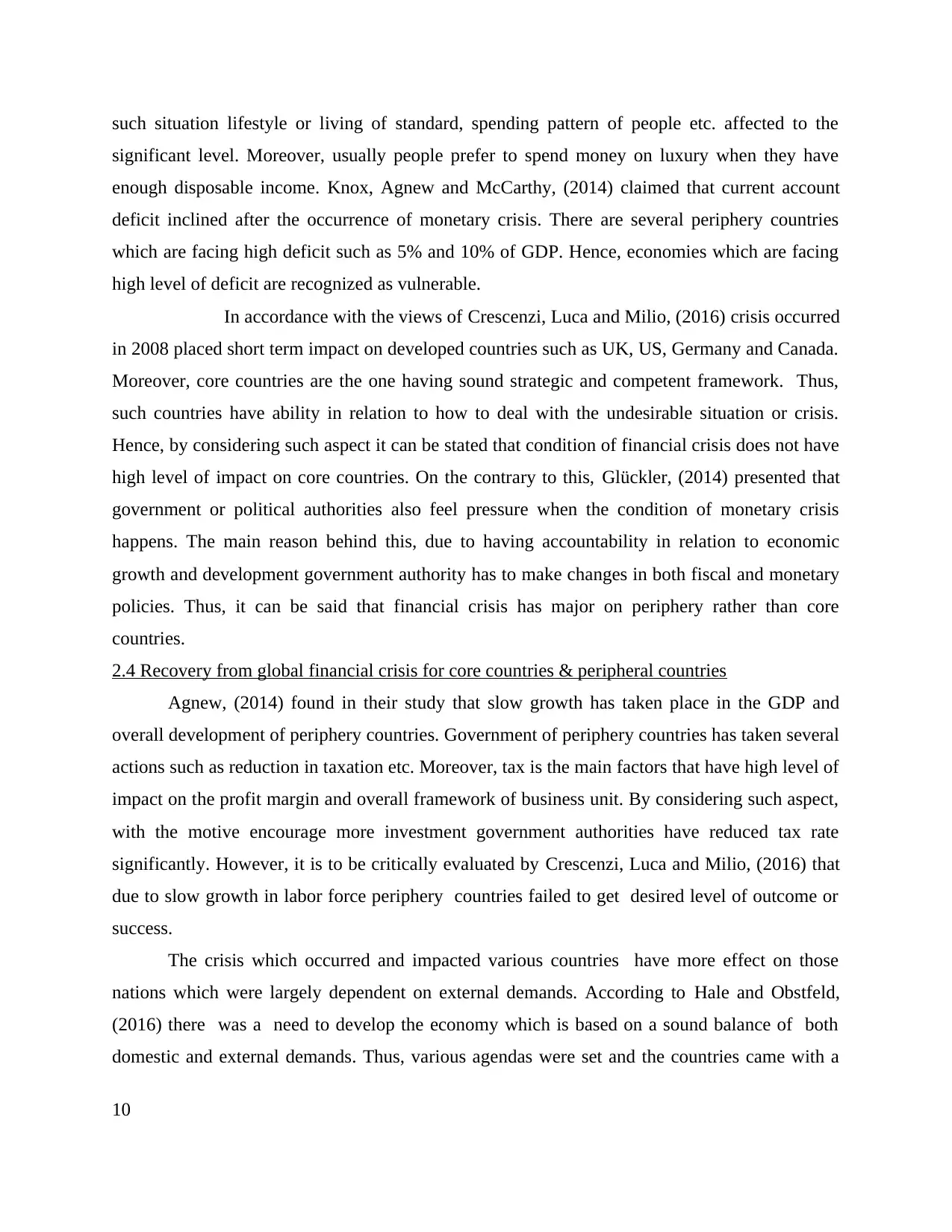
such situation lifestyle or living of standard, spending pattern of people etc. affected to the
significant level. Moreover, usually people prefer to spend money on luxury when they have
enough disposable income. Knox, Agnew and McCarthy, (2014) claimed that current account
deficit inclined after the occurrence of monetary crisis. There are several periphery countries
which are facing high deficit such as 5% and 10% of GDP. Hence, economies which are facing
high level of deficit are recognized as vulnerable.
In accordance with the views of Crescenzi, Luca and Milio, (2016) crisis occurred
in 2008 placed short term impact on developed countries such as UK, US, Germany and Canada.
Moreover, core countries are the one having sound strategic and competent framework. Thus,
such countries have ability in relation to how to deal with the undesirable situation or crisis.
Hence, by considering such aspect it can be stated that condition of financial crisis does not have
high level of impact on core countries. On the contrary to this, Glückler, (2014) presented that
government or political authorities also feel pressure when the condition of monetary crisis
happens. The main reason behind this, due to having accountability in relation to economic
growth and development government authority has to make changes in both fiscal and monetary
policies. Thus, it can be said that financial crisis has major on periphery rather than core
countries.
2.4 Recovery from global financial crisis for core countries & peripheral countries
Agnew, (2014) found in their study that slow growth has taken place in the GDP and
overall development of periphery countries. Government of periphery countries has taken several
actions such as reduction in taxation etc. Moreover, tax is the main factors that have high level of
impact on the profit margin and overall framework of business unit. By considering such aspect,
with the motive encourage more investment government authorities have reduced tax rate
significantly. However, it is to be critically evaluated by Crescenzi, Luca and Milio, (2016) that
due to slow growth in labor force periphery countries failed to get desired level of outcome or
success.
The crisis which occurred and impacted various countries have more effect on those
nations which were largely dependent on external demands. According to Hale and Obstfeld,
(2016) there was a need to develop the economy which is based on a sound balance of both
domestic and external demands. Thus, various agendas were set and the countries came with a
10
significant level. Moreover, usually people prefer to spend money on luxury when they have
enough disposable income. Knox, Agnew and McCarthy, (2014) claimed that current account
deficit inclined after the occurrence of monetary crisis. There are several periphery countries
which are facing high deficit such as 5% and 10% of GDP. Hence, economies which are facing
high level of deficit are recognized as vulnerable.
In accordance with the views of Crescenzi, Luca and Milio, (2016) crisis occurred
in 2008 placed short term impact on developed countries such as UK, US, Germany and Canada.
Moreover, core countries are the one having sound strategic and competent framework. Thus,
such countries have ability in relation to how to deal with the undesirable situation or crisis.
Hence, by considering such aspect it can be stated that condition of financial crisis does not have
high level of impact on core countries. On the contrary to this, Glückler, (2014) presented that
government or political authorities also feel pressure when the condition of monetary crisis
happens. The main reason behind this, due to having accountability in relation to economic
growth and development government authority has to make changes in both fiscal and monetary
policies. Thus, it can be said that financial crisis has major on periphery rather than core
countries.
2.4 Recovery from global financial crisis for core countries & peripheral countries
Agnew, (2014) found in their study that slow growth has taken place in the GDP and
overall development of periphery countries. Government of periphery countries has taken several
actions such as reduction in taxation etc. Moreover, tax is the main factors that have high level of
impact on the profit margin and overall framework of business unit. By considering such aspect,
with the motive encourage more investment government authorities have reduced tax rate
significantly. However, it is to be critically evaluated by Crescenzi, Luca and Milio, (2016) that
due to slow growth in labor force periphery countries failed to get desired level of outcome or
success.
The crisis which occurred and impacted various countries have more effect on those
nations which were largely dependent on external demands. According to Hale and Obstfeld,
(2016) there was a need to develop the economy which is based on a sound balance of both
domestic and external demands. Thus, various agendas were set and the countries came with a
10
Paraphrase This Document
Need a fresh take? Get an instant paraphrase of this document with our AI Paraphraser
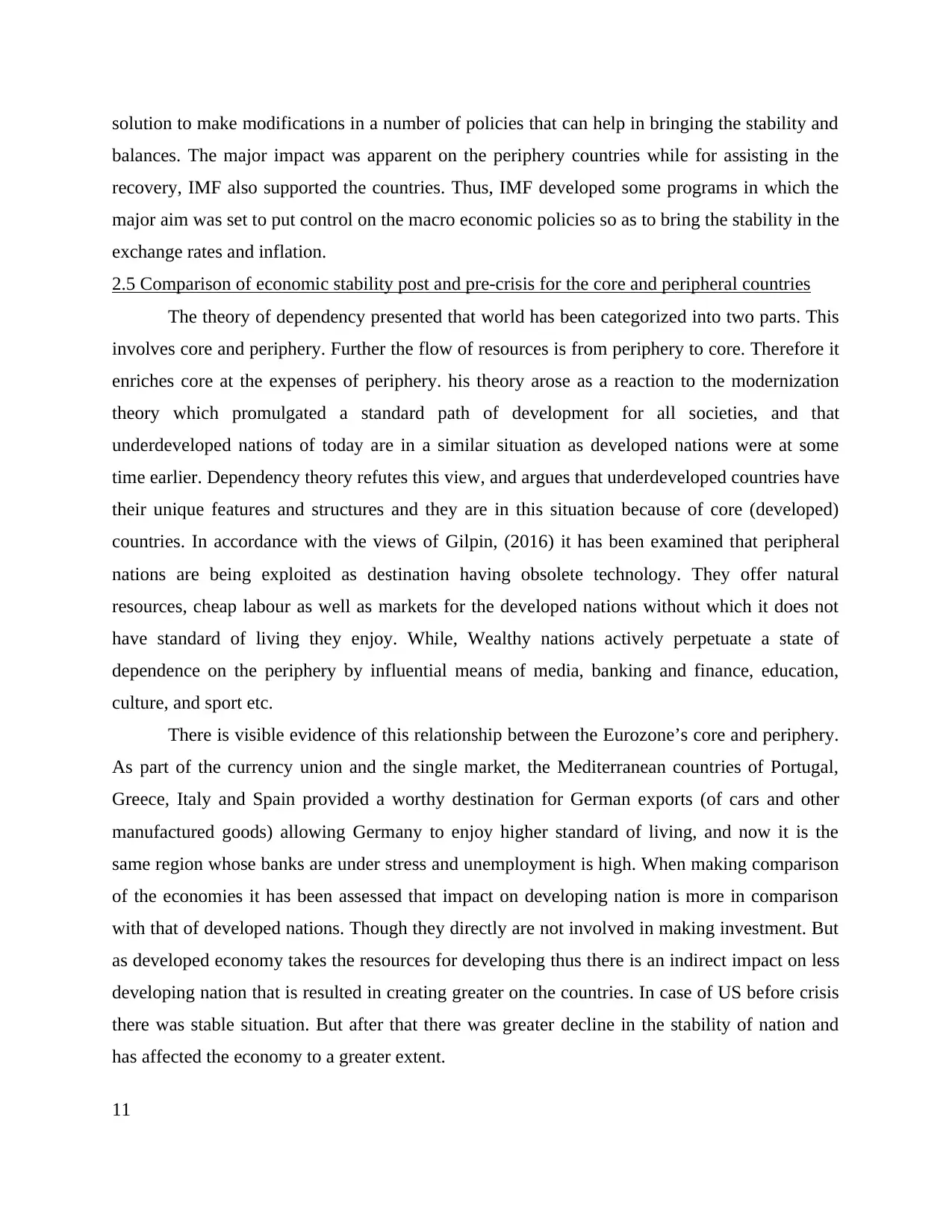
solution to make modifications in a number of policies that can help in bringing the stability and
balances. The major impact was apparent on the periphery countries while for assisting in the
recovery, IMF also supported the countries. Thus, IMF developed some programs in which the
major aim was set to put control on the macro economic policies so as to bring the stability in the
exchange rates and inflation.
2.5 Comparison of economic stability post and pre-crisis for the core and peripheral countries
The theory of dependency presented that world has been categorized into two parts. This
involves core and periphery. Further the flow of resources is from periphery to core. Therefore it
enriches core at the expenses of periphery. his theory arose as a reaction to the modernization
theory which promulgated a standard path of development for all societies, and that
underdeveloped nations of today are in a similar situation as developed nations were at some
time earlier. Dependency theory refutes this view, and argues that underdeveloped countries have
their unique features and structures and they are in this situation because of core (developed)
countries. In accordance with the views of Gilpin, (2016) it has been examined that peripheral
nations are being exploited as destination having obsolete technology. They offer natural
resources, cheap labour as well as markets for the developed nations without which it does not
have standard of living they enjoy. While, Wealthy nations actively perpetuate a state of
dependence on the periphery by influential means of media, banking and finance, education,
culture, and sport etc.
There is visible evidence of this relationship between the Eurozone’s core and periphery.
As part of the currency union and the single market, the Mediterranean countries of Portugal,
Greece, Italy and Spain provided a worthy destination for German exports (of cars and other
manufactured goods) allowing Germany to enjoy higher standard of living, and now it is the
same region whose banks are under stress and unemployment is high. When making comparison
of the economies it has been assessed that impact on developing nation is more in comparison
with that of developed nations. Though they directly are not involved in making investment. But
as developed economy takes the resources for developing thus there is an indirect impact on less
developing nation that is resulted in creating greater on the countries. In case of US before crisis
there was stable situation. But after that there was greater decline in the stability of nation and
has affected the economy to a greater extent.
11
balances. The major impact was apparent on the periphery countries while for assisting in the
recovery, IMF also supported the countries. Thus, IMF developed some programs in which the
major aim was set to put control on the macro economic policies so as to bring the stability in the
exchange rates and inflation.
2.5 Comparison of economic stability post and pre-crisis for the core and peripheral countries
The theory of dependency presented that world has been categorized into two parts. This
involves core and periphery. Further the flow of resources is from periphery to core. Therefore it
enriches core at the expenses of periphery. his theory arose as a reaction to the modernization
theory which promulgated a standard path of development for all societies, and that
underdeveloped nations of today are in a similar situation as developed nations were at some
time earlier. Dependency theory refutes this view, and argues that underdeveloped countries have
their unique features and structures and they are in this situation because of core (developed)
countries. In accordance with the views of Gilpin, (2016) it has been examined that peripheral
nations are being exploited as destination having obsolete technology. They offer natural
resources, cheap labour as well as markets for the developed nations without which it does not
have standard of living they enjoy. While, Wealthy nations actively perpetuate a state of
dependence on the periphery by influential means of media, banking and finance, education,
culture, and sport etc.
There is visible evidence of this relationship between the Eurozone’s core and periphery.
As part of the currency union and the single market, the Mediterranean countries of Portugal,
Greece, Italy and Spain provided a worthy destination for German exports (of cars and other
manufactured goods) allowing Germany to enjoy higher standard of living, and now it is the
same region whose banks are under stress and unemployment is high. When making comparison
of the economies it has been assessed that impact on developing nation is more in comparison
with that of developed nations. Though they directly are not involved in making investment. But
as developed economy takes the resources for developing thus there is an indirect impact on less
developing nation that is resulted in creating greater on the countries. In case of US before crisis
there was stable situation. But after that there was greater decline in the stability of nation and
has affected the economy to a greater extent.
11
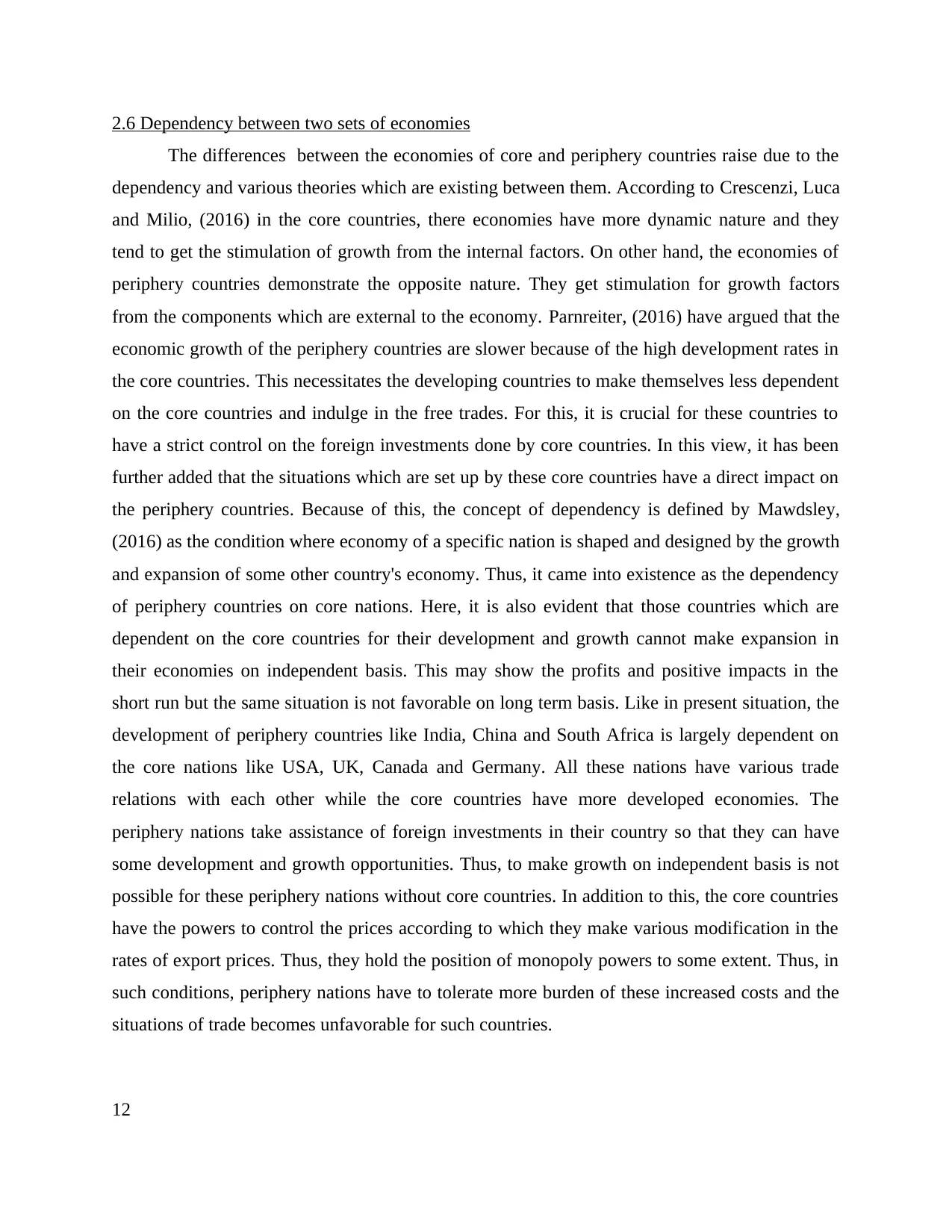
2.6 Dependency between two sets of economies
The differences between the economies of core and periphery countries raise due to the
dependency and various theories which are existing between them. According to Crescenzi, Luca
and Milio, (2016) in the core countries, there economies have more dynamic nature and they
tend to get the stimulation of growth from the internal factors. On other hand, the economies of
periphery countries demonstrate the opposite nature. They get stimulation for growth factors
from the components which are external to the economy. Parnreiter, (2016) have argued that the
economic growth of the periphery countries are slower because of the high development rates in
the core countries. This necessitates the developing countries to make themselves less dependent
on the core countries and indulge in the free trades. For this, it is crucial for these countries to
have a strict control on the foreign investments done by core countries. In this view, it has been
further added that the situations which are set up by these core countries have a direct impact on
the periphery countries. Because of this, the concept of dependency is defined by Mawdsley,
(2016) as the condition where economy of a specific nation is shaped and designed by the growth
and expansion of some other country's economy. Thus, it came into existence as the dependency
of periphery countries on core nations. Here, it is also evident that those countries which are
dependent on the core countries for their development and growth cannot make expansion in
their economies on independent basis. This may show the profits and positive impacts in the
short run but the same situation is not favorable on long term basis. Like in present situation, the
development of periphery countries like India, China and South Africa is largely dependent on
the core nations like USA, UK, Canada and Germany. All these nations have various trade
relations with each other while the core countries have more developed economies. The
periphery nations take assistance of foreign investments in their country so that they can have
some development and growth opportunities. Thus, to make growth on independent basis is not
possible for these periphery nations without core countries. In addition to this, the core countries
have the powers to control the prices according to which they make various modification in the
rates of export prices. Thus, they hold the position of monopoly powers to some extent. Thus, in
such conditions, periphery nations have to tolerate more burden of these increased costs and the
situations of trade becomes unfavorable for such countries.
12
The differences between the economies of core and periphery countries raise due to the
dependency and various theories which are existing between them. According to Crescenzi, Luca
and Milio, (2016) in the core countries, there economies have more dynamic nature and they
tend to get the stimulation of growth from the internal factors. On other hand, the economies of
periphery countries demonstrate the opposite nature. They get stimulation for growth factors
from the components which are external to the economy. Parnreiter, (2016) have argued that the
economic growth of the periphery countries are slower because of the high development rates in
the core countries. This necessitates the developing countries to make themselves less dependent
on the core countries and indulge in the free trades. For this, it is crucial for these countries to
have a strict control on the foreign investments done by core countries. In this view, it has been
further added that the situations which are set up by these core countries have a direct impact on
the periphery countries. Because of this, the concept of dependency is defined by Mawdsley,
(2016) as the condition where economy of a specific nation is shaped and designed by the growth
and expansion of some other country's economy. Thus, it came into existence as the dependency
of periphery countries on core nations. Here, it is also evident that those countries which are
dependent on the core countries for their development and growth cannot make expansion in
their economies on independent basis. This may show the profits and positive impacts in the
short run but the same situation is not favorable on long term basis. Like in present situation, the
development of periphery countries like India, China and South Africa is largely dependent on
the core nations like USA, UK, Canada and Germany. All these nations have various trade
relations with each other while the core countries have more developed economies. The
periphery nations take assistance of foreign investments in their country so that they can have
some development and growth opportunities. Thus, to make growth on independent basis is not
possible for these periphery nations without core countries. In addition to this, the core countries
have the powers to control the prices according to which they make various modification in the
rates of export prices. Thus, they hold the position of monopoly powers to some extent. Thus, in
such conditions, periphery nations have to tolerate more burden of these increased costs and the
situations of trade becomes unfavorable for such countries.
12
⊘ This is a preview!⊘
Do you want full access?
Subscribe today to unlock all pages.

Trusted by 1+ million students worldwide
1 out of 35
Related Documents
Your All-in-One AI-Powered Toolkit for Academic Success.
+13062052269
info@desklib.com
Available 24*7 on WhatsApp / Email
![[object Object]](/_next/static/media/star-bottom.7253800d.svg)
Unlock your academic potential
Copyright © 2020–2025 A2Z Services. All Rights Reserved. Developed and managed by ZUCOL.





